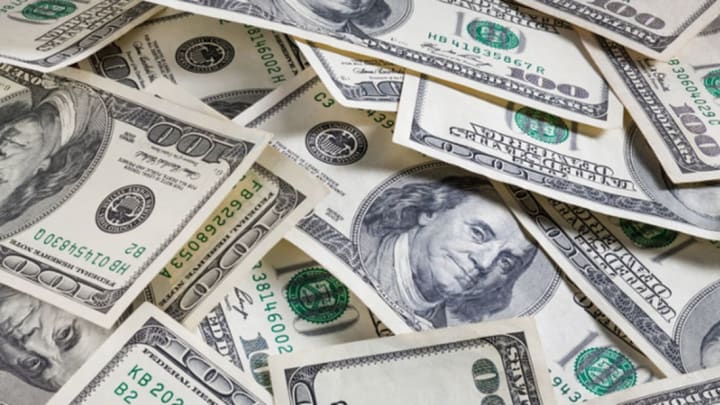Hollywood studios may spend hundreds of millions of dollars to make a movie, but you’ll rarely ever see any real money on the screen. Due to the liabilities involved in having large sums of money in front of cameras, especially when a script calls for thousands or millions of dollars to be shown (or destroyed) in a scene, the movie industry relies on prop currency to create everything from a mobster’s briefcase full of hundreds to a madman's pile of burning bills. But there’s a fine line between creating the perfect prop and unintentionally bringing counterfeit currency into the world.
In the wake of the Civil War, crimes involving counterfeit U.S. currency were on the rise, with some estimates claiming that anywhere from one-third to half of all the country’s money was fake. This prompted the creation of the Secret Service, which was originally conceived to investigate counterfeit crimes. In the immediate aftermath of the war, there was a nationwide effort to crack down on this fake cash, and at one point in the early 20th century, a federal law was briefly put on the books that forbid the use of actual money in full-scale photography.
Up until this point, the nascent movie industry had been using real money in its productions, so according to Pricenomics, the only real solution to this law at the time was for filmmakers to use Mexican currency that was rendered useless after the Mexican Revolution ended in 1920.
That solution turned out to be nothing more than a Band-Aid; as the decades went on, the supply of Mexican currency purchased by the studios began to shrink, leaving producers looking for alternatives. One quick fix came when studios began printing their own prop money, albeit with original designs on the bills, including the studio’s name front and center on each note (since any reproduction of U.S. currency was forbidden at the time, this prop money was based on the Mexican design).
Though the early 20th century laws forbidding real money from being filmed didn’t last long, the problem of finding props that looked authentic persisted through the ‘60s and ‘70s. This is when movie prop houses began to create more believable money that was based on the designs of actual U.S. currency. As the laws surrounding the reproduction of money were loosened, this new prop money passed muster with the Secret Service. Much of this was achieved through black-and-white reproductions of U.S. money that was passable in quick shots.
Over the decades the laws regarding currency reproduction have changed, and today we abide by the Counterfeit Detection Act of 1992. According to the law, filmmakers can reproduce full-color U.S. currency, provided that they adhere to the following restrictions on each bill:
(1) the illustration is of a size less than three-fourths or more than one and one-half, in linear dimension, of each part of the item illustrated; (2) the illustration is one-sided; and (3) all negatives, plates, positives, digitized storage medium, graphic files, magnetic medium, optical storage devices, and any other thing used in the making of the illustration that contain an image of the illustration or any part thereof are destroyed and/or deleted or erased after their final use.
If a prop company comes too close to the real thing, they can expect a not-so-friendly visit from the Secret Service, as Independent Studio Services found out after some of its faux money from Rush Hour 2 made its way into the local economy. The company was ordered to destroy its entire inventory of prop money at a considerable loss, which led Gregg Bilson Jr., the CEO of Independent Studio Services, to rethink the prop money strategy. To avoid more run-ins with the Feds, his company now prints stacks of blank bill paper and places a lone, authentic $100 bill on top to simulate a large sum of cash.
Today, prop money still gets passed off as authentic from time to time, even if the bills follow the federal guidelines of reproduction. As Secret Service special agent Chuck Ortman explained to the Los Angeles Times, “[If] it's green and it says '20' on it, somebody will take it."
